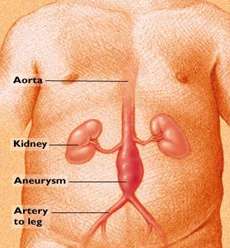Abdominal Aortic Aneurysm (AAA)
The aorta is the largest artery in the body, and the main blood vessel carrying blood throughout the body. An abdominal aortic aneurysm (AAA) is an area of weakening in the wall of the artery that may begin to bulge of dilate. This is thought to be caused by an imbalance in the build-up and break-down of the aortic wall. If the aneurysm becomes large enough, it may rupture.
AAA's occur in about 5% of men over the age of 60 and in women over the age of 70. It is the 10 th leading cause of death in men over the age of 55, usually due to the rupture (bursting) of the aneurysm; 80-90% of ruptured aneurysms result in death.
Risk Factors:
The risk factors for AAA are similar to those of atherosclerosis (build up of fatty substances along the inner walls of the arteries).Age (anyone aged 50+)
Family history of AAA
Hypertension (high blood pressure)
Male gender
Smoking
Symptoms:
Most patients (about 70-75%) with AAA have NO symptoms. If the aneurysm begins to leak or rupture, you may experience:Abdominal or back pain
Flank or groin pain
Loss of consciousness
Low blood pressure
Diagnosis:
AAA's are often found incidentally during a routine physical examination by feeling a pulsating mass in the abdomen or on an X-ray exam performed for other reasons.Imaging modalities used to diagnose and characterize AAA include:
Angiography: an X-ray dye study often required to plan endovascular stent graft repair.
CT Scan: a specialized X-ray that shows the size and extent of the aneurysm and is used for planning operative repair.
Ultrasound: a noninvasive test that can determine the presence and size of an aneurysm.
Treatment:
Repair is the only treatment for AAA. Small AAA's (< 5cm) should be regularly followed with ultrasound to track changes in the size of the aneurysm.Endovascular grafting or open surgery is typically performed when the AAA reaches 5cm or larger in size due to increasing risk of rupture.

